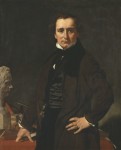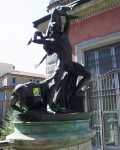 A unique life-sized marble sculpture capturing the lovely young Campbell sisters mid-dance has been jointly acquired by the Victoria & Albert and the Scottish National Gallery. The sculptural group sold at auction last July for $868,090 to a foreign buyer. To keep the rare masterpiece in the country, the sale price was raised by the museums thanks to grants from the National Heritage Memorial Fund and the Art Fund. The V&A and the Scottish National Gallery will share joint custody of The Campbell Sisters, each museum displaying it for seven years at a time.
A unique life-sized marble sculpture capturing the lovely young Campbell sisters mid-dance has been jointly acquired by the Victoria & Albert and the Scottish National Gallery. The sculptural group sold at auction last July for $868,090 to a foreign buyer. To keep the rare masterpiece in the country, the sale price was raised by the museums thanks to grants from the National Heritage Memorial Fund and the Art Fund. The V&A and the Scottish National Gallery will share joint custody of The Campbell Sisters, each museum displaying it for seven years at a time.
 Made by Florentine sculptor Lorenzo Bartolini around 1821, The Campbell Sisters Dancing a Waltz depicts the girls stepping lively side-by-side as their delicately draped gowns seem to flutter in the breeze. (It was Bartolini who dubbed the dance a “Valtzer” even though it’s obvious they’re not waltzing. The face-to-face whirling dance we know as the waltz became popular in aristocratic circles starting in the 1770s, so you’d think he would have been familiar with it.) Sisters Emma and Julia were the youngest of the eight children of Lady Charlotte Campbell, daughter of the 5th Duke of Argyll, and her distant cousin/husband John Campbell. It wasn’t a great match, fortune-wise, and after his death the Lady Charlotte had significant money troubles. By the time Bartolini immortalized Emma and Julia in graceful motion, they were living with their widowed mother in Florence where a noblewoman in reduced circumstances could live more comfortably than she could in England or Scotland.
Made by Florentine sculptor Lorenzo Bartolini around 1821, The Campbell Sisters Dancing a Waltz depicts the girls stepping lively side-by-side as their delicately draped gowns seem to flutter in the breeze. (It was Bartolini who dubbed the dance a “Valtzer” even though it’s obvious they’re not waltzing. The face-to-face whirling dance we know as the waltz became popular in aristocratic circles starting in the 1770s, so you’d think he would have been familiar with it.) Sisters Emma and Julia were the youngest of the eight children of Lady Charlotte Campbell, daughter of the 5th Duke of Argyll, and her distant cousin/husband John Campbell. It wasn’t a great match, fortune-wise, and after his death the Lady Charlotte had significant money troubles. By the time Bartolini immortalized Emma and Julia in graceful motion, they were living with their widowed mother in Florence where a noblewoman in reduced circumstances could live more comfortably than she could in England or Scotland.
Given their comparative brokeness, it’s not certain who commissioned the work. According to Bartolini’s studio notes, the sculpture was commissioned by the girls’ brother Mr. Campbell, but the whole family had limited funds so it’s unlikely their eldest brother Walter would have spent £500 on a marble life-sized portrait of his sisters. Perhaps a more likely candidate is the girls’ uncle, Lady Charlotte’s brother, George William Campbell, the 6th Duke of Argyll. Bartolini’s notes say they shipped it to Edinburgh and at some point the sculpture wound up in the dining room of Inveraray Castle, seat of the Dukes of Argyll. There are no references to its arrival in the castle archives.
 Bartolini was famous in his time for his portrait sculptures. He had been one of Napoleon’s favorites and his fortunes suffered somewhat in the wake of his patron’s final defeat and exile, but he made a decent living in the late 18teens and twenties in large part thanks to portrait commissions. A great many portrait busts of prominent men and women of the period (the Bonaparte siblings and spouses, Alexander I of Russia, the Duke of Alba, the Duchess of Sutherland and dozens more) made by Bartolini are in museums and collections all over Europe and the United States today.
Bartolini was famous in his time for his portrait sculptures. He had been one of Napoleon’s favorites and his fortunes suffered somewhat in the wake of his patron’s final defeat and exile, but he made a decent living in the late 18teens and twenties in large part thanks to portrait commissions. A great many portrait busts of prominent men and women of the period (the Bonaparte siblings and spouses, Alexander I of Russia, the Duke of Alba, the Duchess of Sutherland and dozens more) made by Bartolini are in museums and collections all over Europe and the United States today.
 Canova’s static, posed neoclassical aesthetic still dominated, while Bartolini preferred a softer, more naturalistic approach he’d learned studying painting in Paris under Jacques-Louis David. Despite his eye for naturalism and movement so clearly evinced in The Campbell Sisters, the portrait of the young ladies is one of only two action sculptures made by Bartolini. The other one was Neoptolemus Casting Astyanax from the Walls of Troy, made in 1841 and widely considered Bartolini’s chef-d’oeuvre. Commissioned by Donna Rosa Poldi-Pezzoli, the Astyanax group would become the core of Poldi-Pezzoli Museum founded in Milan by her son Don Gian-Giacomo. Bartolini created a scene of dynamic action — Neoptolemus (aka Pyrrhus) about to throw the child Astyanx from Troy’s ramparts to his death while his mother Andromache lies prostrate at his feet, one arm reaching up his leg — in marked contrast to his static portraits.
Canova’s static, posed neoclassical aesthetic still dominated, while Bartolini preferred a softer, more naturalistic approach he’d learned studying painting in Paris under Jacques-Louis David. Despite his eye for naturalism and movement so clearly evinced in The Campbell Sisters, the portrait of the young ladies is one of only two action sculptures made by Bartolini. The other one was Neoptolemus Casting Astyanax from the Walls of Troy, made in 1841 and widely considered Bartolini’s chef-d’oeuvre. Commissioned by Donna Rosa Poldi-Pezzoli, the Astyanax group would become the core of Poldi-Pezzoli Museum founded in Milan by her son Don Gian-Giacomo. Bartolini created a scene of dynamic action — Neoptolemus (aka Pyrrhus) about to throw the child Astyanx from Troy’s ramparts to his death while his mother Andromache lies prostrate at his feet, one arm reaching up his leg — in marked contrast to his static portraits.
 Sadly the sculpture and its plaster model were destroyed by aerial bombing in World War II. A bronze replica made in 1902 after the original marble, then located in the courtyard of the museum building, was damaged in a hailstorm, has survived, as have preparatory drawings now in the Uffizi and the Morgan Library and Museum. That makes The Campbell Sisters the only surviving Bartolini sculpture that captures characters in movement. Because of that and because it’s a much earlier work that uniquely combines the portraiture he was best known for and an action scene, the UK museums are thrilled to get to keep The Campbell Sisters.
Sadly the sculpture and its plaster model were destroyed by aerial bombing in World War II. A bronze replica made in 1902 after the original marble, then located in the courtyard of the museum building, was damaged in a hailstorm, has survived, as have preparatory drawings now in the Uffizi and the Morgan Library and Museum. That makes The Campbell Sisters the only surviving Bartolini sculpture that captures characters in movement. Because of that and because it’s a much earlier work that uniquely combines the portraiture he was best known for and an action scene, the UK museums are thrilled to get to keep The Campbell Sisters.
It is on display at the V&A right now, where it will remain until November 20th. After that, it moves to the Scottish National Gallery in Edinburgh for the first seven year visitation period. For more about Lorenzo Bartolini, peruse the marvel that is this website dedicated to the artist and his art by Florence’s Galleria dell’Accademia. It literally has his entire output in the Works gallery, plus gobs more information everywhere. The English version works too! I don’t know how many times I’ve seen the alternate languages of smaller museum sites only have a single introductory page while all the rest of the links are broken.